Effect of Different Voltage Frequencies of Plasma Actuators on Wind Turbine Blade Lift and Rudder Efficiency
Abstract
1. Introduction
2. Computational Model
2.1. Model and Computational Domain Grid
2.2. Plasma Actuator Phenomenological Model
2.3. Rudder Efficiency and Turbulence Modeling
2.4. Model Accuracy Validation
3. Results and Analysis
3.1. Effect of Actuator Voltage Frequency on Lift Coefficient
3.1.1. Effect of Voltage Frequency on Lift at α = 0°
3.1.2. Effect of Voltage Frequency on Lift at α = 15°
3.2. Effect of Actuator Voltage Frequency on Rudder Efficiency
3.2.1. Effect of Voltage Frequency on Rudder Efficiency at α = 0°
3.2.2. Effect of Voltage Frequency on Rudder Efficiency at α = 15°
3.3. Flow Field Analysis
3.3.1. Flow Field Analysis at α = 0°
3.3.2. Flow Field Analysis at α = 15°
4. Conclusions
- (a)
- The lift and rudder efficiency of the blade at both 0° and 15° angles of attack can be effectively improved by the actuator, and then the efficiency of wind turbine power generation is effectively improved. The actuator’s influence upon the rudder efficiency is increased as the rudder deflection angle decreases at α = 0°. However, at α = 15°, the complex flow of airflow around the blade leads to the fact that the enhancement effect of the actuator on the rudder efficiency does not show a regular change with the rudder deflection angle. The enhancement effect of the actuator on the rudder efficiency is amplified with the rise of the voltage frequency for both angles of attack.
- (b)
- When α = 0°, flow separation is only caused at the leading edge of the rudder, and only attached vortices are generated above the rudder. When α = 15°, flow separation is caused when the airflow passes through the main blade, and multiple vortices are formed above the blade, making the flow situation more complicated. Moreover, at α = 15°, three types of lift coefficient curves are generated by applying the plasma actuator: delta function type, irregular oscillation type, and oscillation delta function type. To reduce the issue of blade flutter created by the drastic change in the lift coefficient, the oscillating delta function type of curve should be avoided when selecting the voltage frequency. At the same time, to accomplish high lift coefficient and low energy consumption, voltage-frequency plasma actuators with jumping characteristics can be used.
- (c)
- As the excitation frequency of the plasma actuator grows at α = 0°, the attached vortex area above the rudder gradually reduces. As a result, the fluid flow velocity is gradually accelerated, causing the flow to move closer to the rudder. As the excitation frequency of the plasma actuator increases at α = 15°, the angle of the flow trajectory of the fluid flowing from the gap at the lower edge to the upper edge is gradually increased. It is indicated that the increase in the voltage frequency contributes to the fluid flow being moved closer to the rudder. Especially when the voltage frequency reaches 8 kHz, the original flow state can be effectively changed, causing the fluid to be closer to the rudder.
Author Contributions
Funding
Data Availability Statement
Conflicts of Interest
Abbreviations
| DBD | Dielectric barrier discharge |
| na | No actuator |
References
- Jureczko, M.; Mrowka, M. Multiobjective Optimization of Composite Wind Turbine Blade. Materials 2022, 15, 4649. [Google Scholar] [CrossRef] [PubMed]
- Teng, H.; Li, S.; Cao, Z.; Li, S.; Li, C.; Ko, T.J. Carbon Fiber Composites for Large-Scale Wind Turbine Blades: Applicability Study and Comprehensive Evaluation in China. J. Mar. Sci. Eng. 2023, 11, 624. [Google Scholar] [CrossRef]
- Zhang, Y.; Zhang, C.; You, H.; Liang, K.; Wei, C.; Sun, A. Analysis of performance improvement methods for offshore wind turbine blades affected by leading edge erosion. Ocean Eng. 2024, 310, 118773. [Google Scholar] [CrossRef]
- Chu, Y.-J.; Lam, H.-F.; Peng, H.-Y. Numerical investigation of the power and self-start performance of a folding-blade horizontal axis wind turbine with a downwind configuration. Int. J. Green Energy 2022, 19, 28–51. [Google Scholar] [CrossRef]
- Zhang, X.; Zheng, M. Numerical Simulation of Fluid-Structure Coupling for a Multi-Blade Vertical-Axis Wind Turbine. Appl. Sci. Basel 2023, 13, 8612. [Google Scholar] [CrossRef]
- Yan, P.; Li, Y.; Gao, Q.; Lian, S.; Wu, Q. Design and Analysis of an Adaptive Dual-Drive Lift-Drag Composite Vertical-Axis Wind Turbine Generator. Energies 2023, 16, 7529. [Google Scholar] [CrossRef]
- Sato, M. Passive Fault-Tolerant Flight Control Design Example for Elevator Efficiency Reduction Using Structured H∞ Control. In Proceedings of the 29th Mediterranean Conference on Control and Automation (MED), Puglia, Italy, 22–25 June 2021; pp. 627–632. [Google Scholar]
- Kim, S.; Horspool, K.R. Nonlinear Controller Design for Non-minimum Phase Flight System Enhanced by Adaptive Elevator Algorithm. In Proceedings of the AIAA Science and Technology Forum and Exposition (AIAA SciTech), Orlando, FL, USA, 6–10 January 2020. [Google Scholar]
- Singh, Y.; Bagri, K.; Jayakumar, A.; Rizzoni, G. Fault Diagnostics for Oscillatory Failure Case in Aircraft Elevator Servos. In Proceedings of the 22nd World Congress of the International Federation of Automatic Control (IFAC), Yokohama, Japan, 9–14 July 2023; pp. 408–415. [Google Scholar]
- Singh, U.; Rizwan, M.; Malik, H.; Marquez, F.P.G. Wind Energy Scenario, Success and Initiatives towards Renewable Energy in India-A Review. Energies 2022, 15, 2291. [Google Scholar] [CrossRef]
- Urabe, C.T.; Ikegami, T.; Ogimoto, K. Mitigation of Short-Term Fluctuations in Wind Power Output in a Balancing Area on the Road Toward 100% Renewable Energy. EEE Access 2022, 10, 111210–111220. [Google Scholar] [CrossRef]
- Esmaeili, A.; Sousa, J.M.M. Combined passive and active flow control for fixed-wing micro air vehicles. Int. J. Micro Air Veh. 2023, 15, 17568293231197127. [Google Scholar] [CrossRef]
- Gupta, S.; Kumar, S.; Kumar, R. Control of leading-edge vortices over delta wing using flow control methods: A review. In Proceedings of the 2nd International Conference on Functional Material, Manufacturing and Performances (ICFMMP), Phagwara, India, 17–18 September 2022; pp. 2189–2193. [Google Scholar]
- Rashid, S.; Nawaz, F.; Maqsood, A.; Salamat, S.; Riaz, R. Review of wave drag reduction techniques: Advances in active, passive, and hybrid flow control. Proc. Inst. Mech. Eng. Part G J. Aerosp. Eng. 2022, 236, 2851–2884. [Google Scholar] [CrossRef]
- Spens, A.; Pisano, A.P.; Bons, J.P. Leading-Edge Active Flow Control Enabled by Curved Fluidic Oscillators. AIAA J. 2023, 61, 1675–1686. [Google Scholar] [CrossRef]
- Zhao, G.; Zhao, Q.; Li, P.; Wang, B. Numerical Investigations for Passive and Active Flow Control on Tiltrotor-Wing Aerodynamic Interactions. J. Aerosp. Eng. 2021, 34, 04021094. [Google Scholar] [CrossRef]
- Hai-long, S.; Obwogi, E.O.; Yu-min, S. Scale effects for rudder bulb and rudder thrust fin on propulsive efficiency based on computational fluid dynamics. Ocean Eng. 2016, 117, 199–209. [Google Scholar] [CrossRef]
- Liu, J.; Hekkenberg, R. Sixty years of research on ship rudders: Effects of design choices on rudder performance. Ships Offshore Struct. 2017, 12, 495–512. [Google Scholar] [CrossRef]
- Benedetti, D.M.; Veras, C.A.G. Wind-Tunnel Measurement of Differential Pressure on the Surface of a Dynamically Inflatable Wing Cell. Aerospace 2021, 8, 34. [Google Scholar] [CrossRef]
- Carstensen, B.; Krüger, S. Coupling of a Boundary Element Method With a Boundary Layer Method for Accurate Rudder Force Calculation Within the Early Design Stage. In Proceedings of the 40th ASME International Conference on Ocean, Offshore and Arctic Engineering (OMAE), Electr Network, Virtual, 21–30 June 2021. [Google Scholar]
- Lin, M.; Yang, F.; Wang, C. Numerical investigation on the generation mechanism of aero-heating of rudder shaft from three-dimensional flow separation and vortices. AIP Adv. 2022, 12, 045228. [Google Scholar] [CrossRef]
- Abdullaev, A.; Kotvitskii, A.; Moralev, I.; Ustinov, M. On the Possibility of Cross-Flow Vortex Cancellation by Plasma Actuators. Aerospace 2023, 10, 469. [Google Scholar] [CrossRef]
- Chen, S.; Shi, Z.; Zhao, Z.; Geng, X.; Chen, Z. Investigation of vertical tail buffeting alleviation controlled by nanosecond plasma actuators. Phys. Fluids 2021, 33, 087109. [Google Scholar] [CrossRef]
- Manuilovich, S.V. Stability and Receptivity of the Swept-Wing Boundary-Layer Flow Controlled by a Periodic Sequence of Plasma Actuators. Fluid Dyn. 2021, 56, 630–644. [Google Scholar] [CrossRef]
- Manuilovich, S.V. Resonance Impact of a Periodic Sequence of Plasma Actuators in Flow Control in a Swept-Wing Boundary Layer. Fluid Dyn. 2023, 58, 542–554. [Google Scholar] [CrossRef]
- Yu, J.; Liu, H.; Xu, D.; Chen, F. Investigation of the DBD Plasma Effect on Flat Plate Flow. Plasma Sci. Technol. 2014, 16, 197–202. [Google Scholar] [CrossRef]
- Benmoussa, A.; Páscoa, J.C. Enhancement of a cycloidal self-pitch vertical axis wind turbine performance through DBD plasma actuators at low tip speed ratio. Int. J. Thermofluids 2023, 17, 100258. [Google Scholar]
- Omidi, J. DBD plasma actuator effect on mid-blade aerodynamics enhancement of a NREL 5-MW wind turbine. In Proceedings of the 2022 International Conference on Futuristic Technologies in Control Systems & Renewable Energy (ICFCR), Malappuram, India, 21–22 July 2022; pp. 1–6. [Google Scholar]
- Omidi, J.; Mazaheri, K. Aerodynamic Enhancement and Improving the Performance of a Six-Megawatt DOWEC Wind Turbine by Micro-Plasma Actuator. Int. J. Mech. Sci. 2021, 195, 106228. [Google Scholar] [CrossRef]
- Li, G.; Zhang, W.; Jiang, Y.; Yang, P. Experimental investigation of dynamic stall flow control for wind turbine airfoils using a plasma actuator. Energy 2019, 185, 90–101. [Google Scholar] [CrossRef]
- Govindan, S.S.; Santiago, A.E.X. Optimized dielectric barrier discharge-plasma actuator for active flow control in wind turbine. Struct. Control. Health Monit. 2019, 26, e2454. [Google Scholar] [CrossRef]
- Papadopoulos, C.; Kaparos, P.; Vlahostergios, Z.; Misirlis, D.; Yakinthos, K. 2D optimization of a Small Horizontal Axis Wind Turbine blade using flow control techniques. In IOP Conference Series: Materials Science and Engineering, Proceedings of the 10th EASN International Conference on Innovation in Aviation & Space to the Satisfaction of the European Citizens (10th EASN 2020), Virtual, 2–4 of September 2020; IOP Science: Bristol, UK, 2021; p. 012041. [Google Scholar]
- Omidi, J. Advances and opportunities in wind energy harvesting using plasma actuators: A review. Clean Energy 2024, 8, 197–225. [Google Scholar]
- Wang, X.; Yan, J.; Dhupia, J.S.; Zhu, X. Active Flow Control Based on Plasma Synthetic Jet for Flapless Aircraft. IEEE Access 2021, 9, 24305–24313. [Google Scholar] [CrossRef]
- Almuina Pica, D.E.; Keener, K.; Lubitz, W.D. Control of Crosswind Force on Aircraft Vertical Tail Models using Plasma Actuators. In Proceedings of the AIAA Scitech 2022 Forum, San Diego, CA, USA, 3–7 January 2022; p. 0832. [Google Scholar]
- Cai, J.; Li, C.; Li, H.; Meng, X. Design and Test of Plasma Control Surface on Unmanned Aerial Vehicle. In The Proceedings of the 2018 Asia-Pacific International Symposium on Aerospace Technology (APISAT 2018) 9th; Zhang, X., Ed.; Springer: Berlin/Heidelberg, Germany, 2019; pp. 1298–1311. [Google Scholar]
- Greenblatt, D.; Schulman, M.; Ben-Harav, A. Vertical axis wind turbine performance enhancement using plasma actuators. Renew. Energy 2012, 37, 345–354. [Google Scholar] [CrossRef]
- Chern, M.-J.; Wang, C.-C.; Wei, Z.-H.; Lu, P.-C. Numerical Investigation of a Pitching NACA 0012 Wing with Plasma-Based Flow Control Using Prediction-Correction Direct-Forcing Immersed Boundary Method. J. Aerosp. Eng. 2023, 36, 04023066. [Google Scholar] [CrossRef]
- Chernyshev, S.; Gadzhimagomedov, G.; Kuryachiy, A.; Sboev, D.; Tolkachev, S. 3D Turbulent Boundary Layer Separation Control by Multi-Discharge Plasma Actuator. Aerospace 2023, 10, 73–85. [Google Scholar] [CrossRef]
- Zafarghandi, F.M.; Soltani, M.R. Experimental Investigation of the Active Flow Control over a Cranked-Delta Wing. J. Aircr. 2024, 61, 73–85. [Google Scholar] [CrossRef]
- Shyy, W.; Jayaraman, B.; Andersson, A. Modeling of glow discharge-induced fluid dynamics. J. Appl. Phys. 2002, 92, 6434–6443. [Google Scholar]
- Zhao, Y.-J.; Zhou, Y.; Ji, K.-X.; Zhao, X.-Y.; Shao, X.; Chang, J.-L. Influence of Rudder Deflection Angle on Airfoil Lift Characteristics Under the Effect of Synthetic Jet Actuator. J. Nanoelectron. Optoelectron. 2021, 16, 1475–1484. [Google Scholar] [CrossRef]
- Wei, B.; Wu, Y.; Liang, H.; Su, Z.; Li, Y. Flow control on a high-lift wing with microsecond pulsed surface dielectric barrier discharge actuator. Aerosp. Sci. Technol. 2020, 96, 105584. [Google Scholar] [CrossRef]
- Abdollahzadeh, M.; Pascoa, J.C.; Oliveira, P.J. Comparison of DBD plasma actuators flow control authority in different modes of actuation. Aerosp. Sci. Technol. 2018, 78, 183–196. [Google Scholar] [CrossRef]

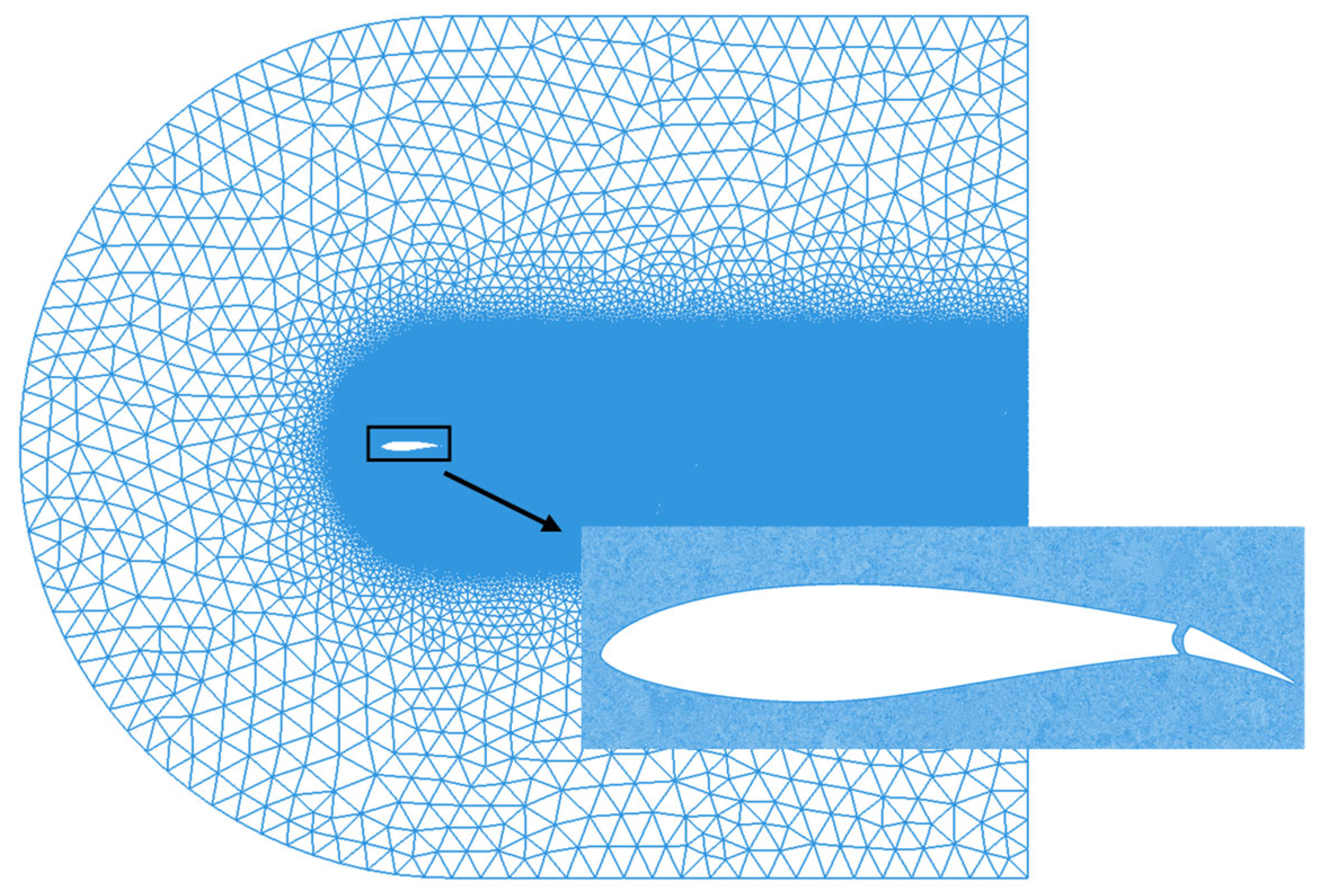
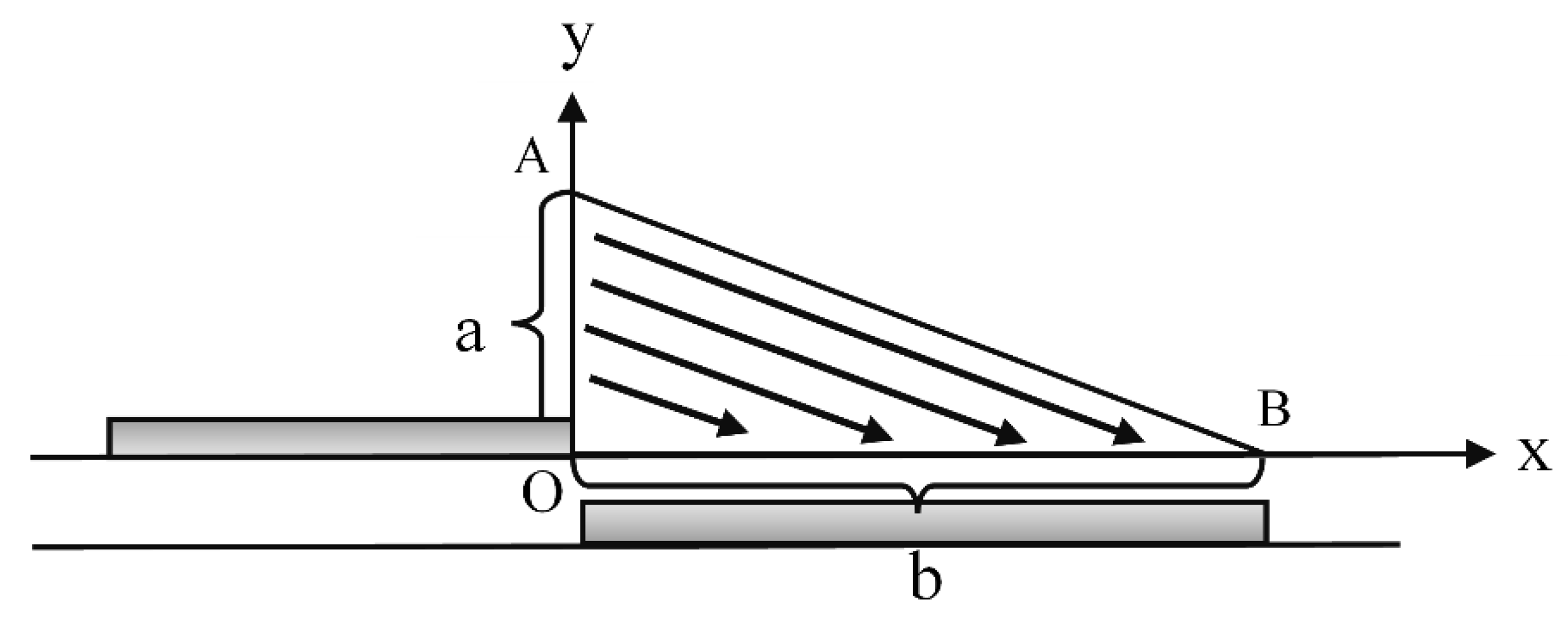
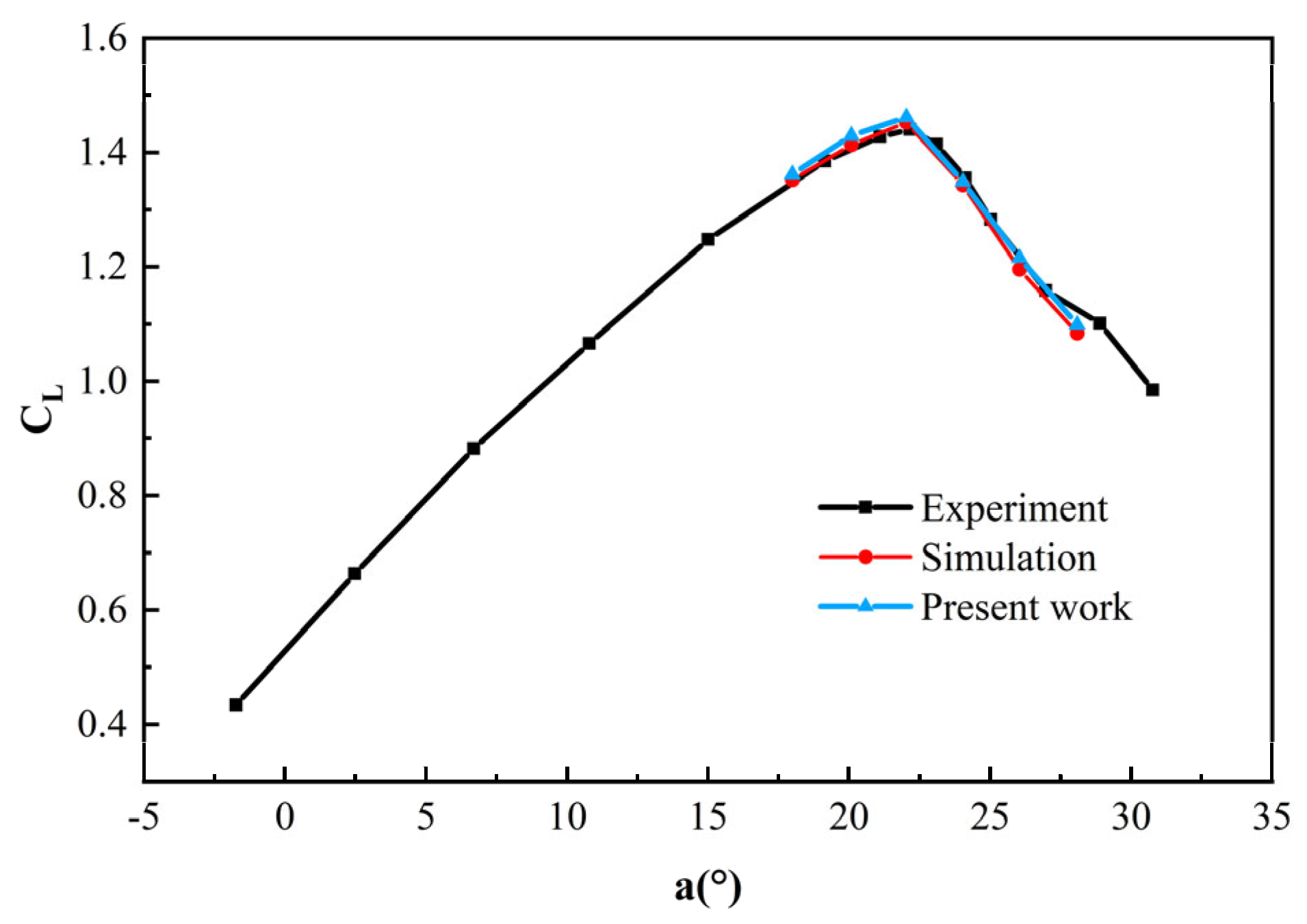
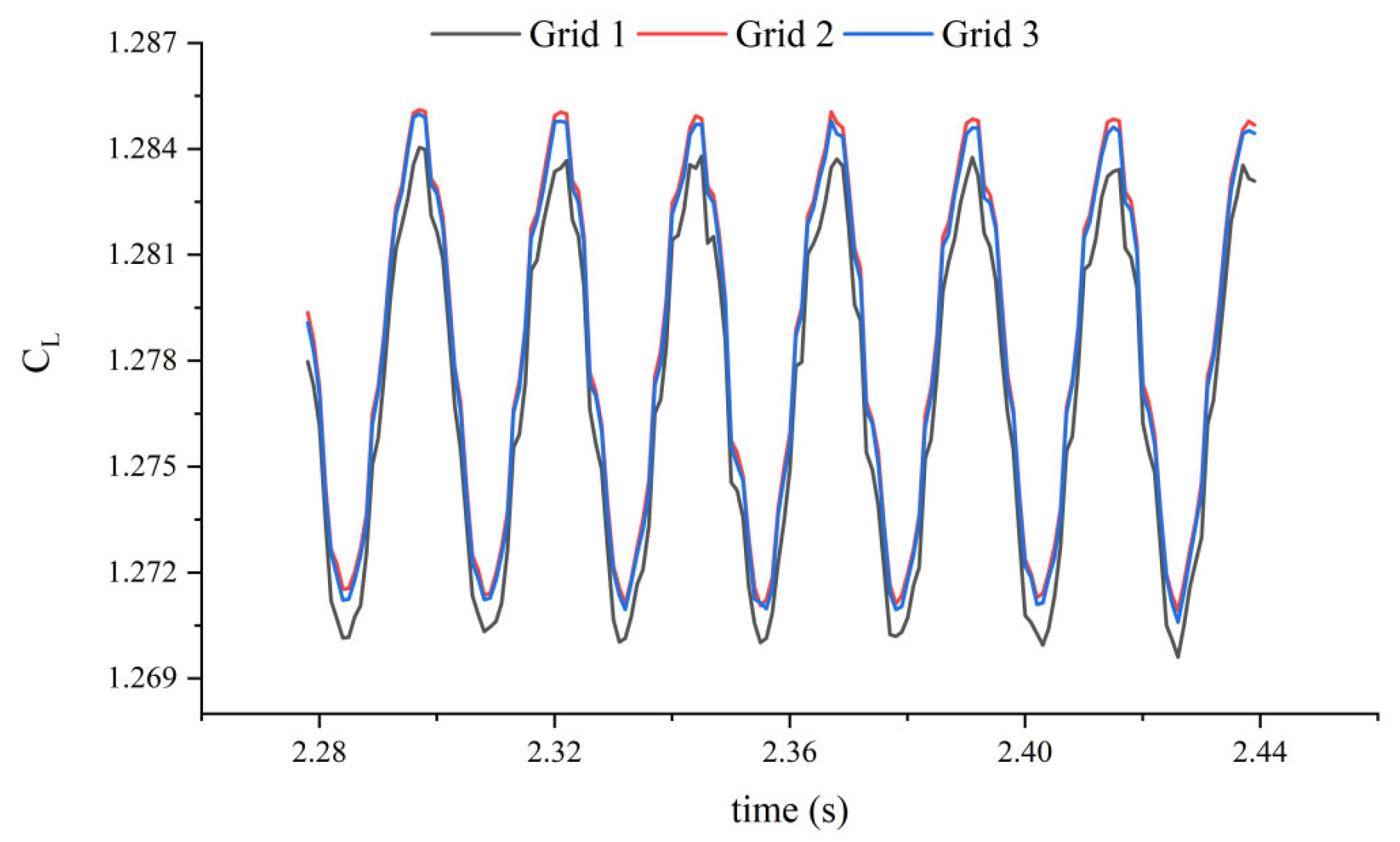
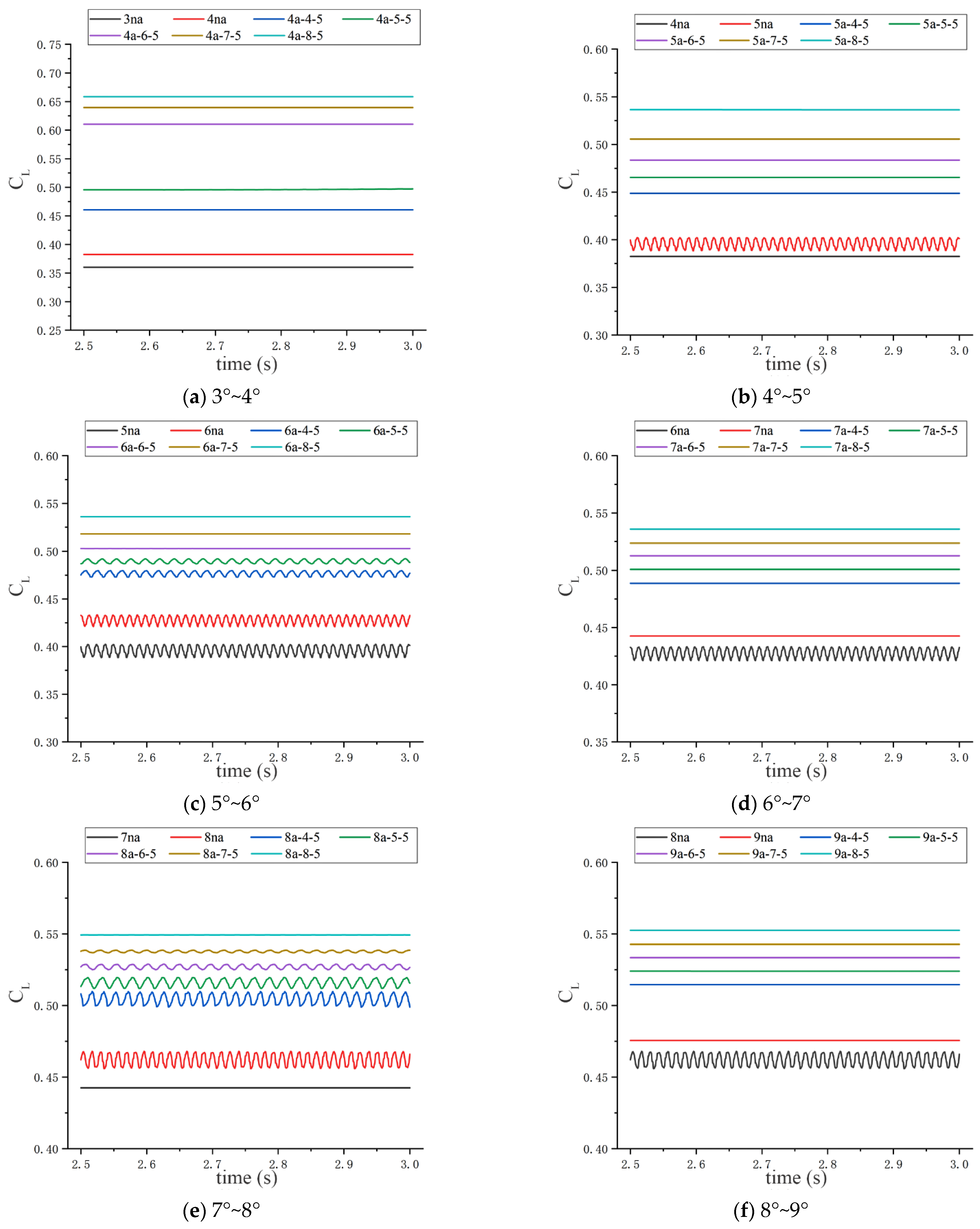

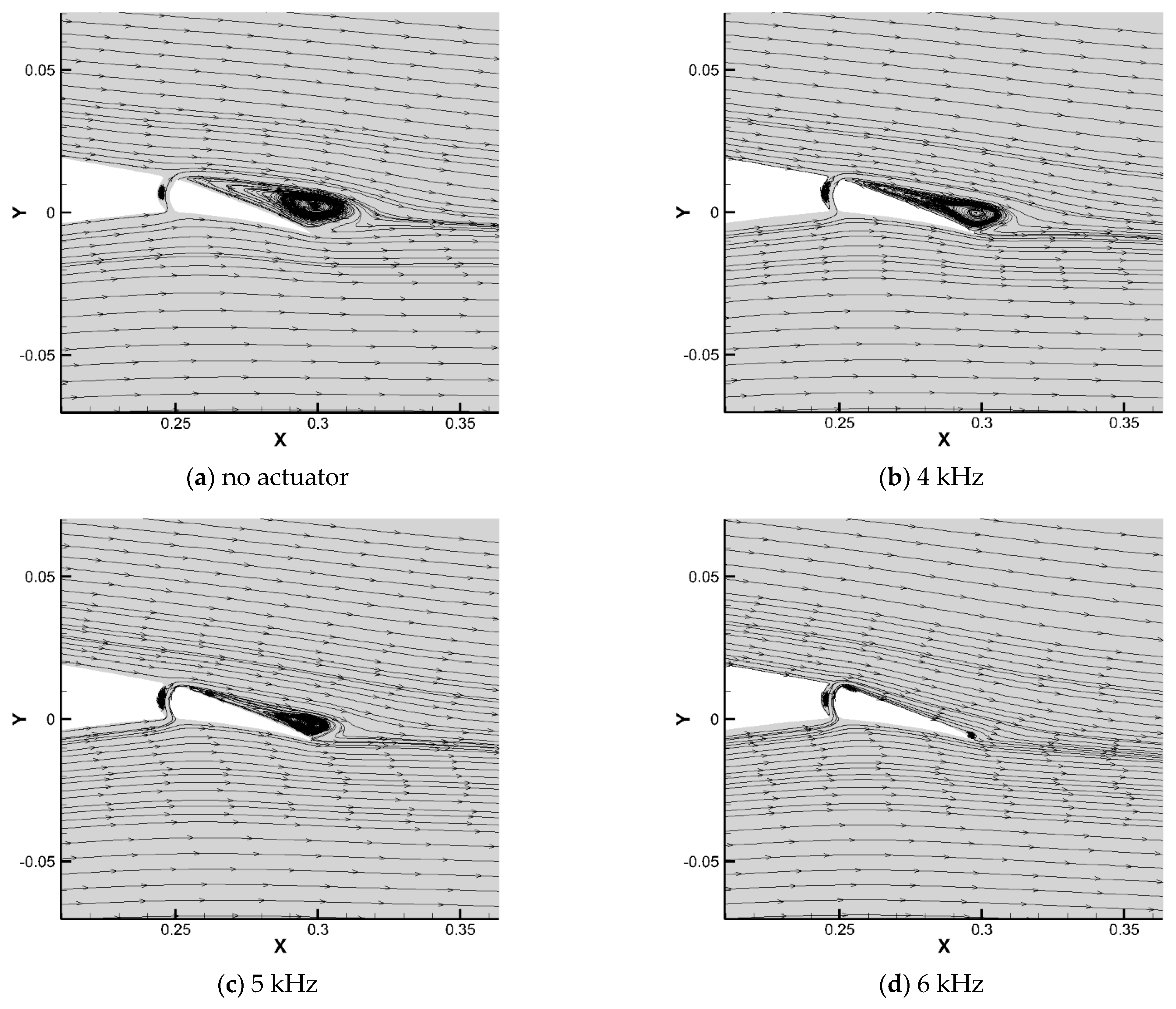
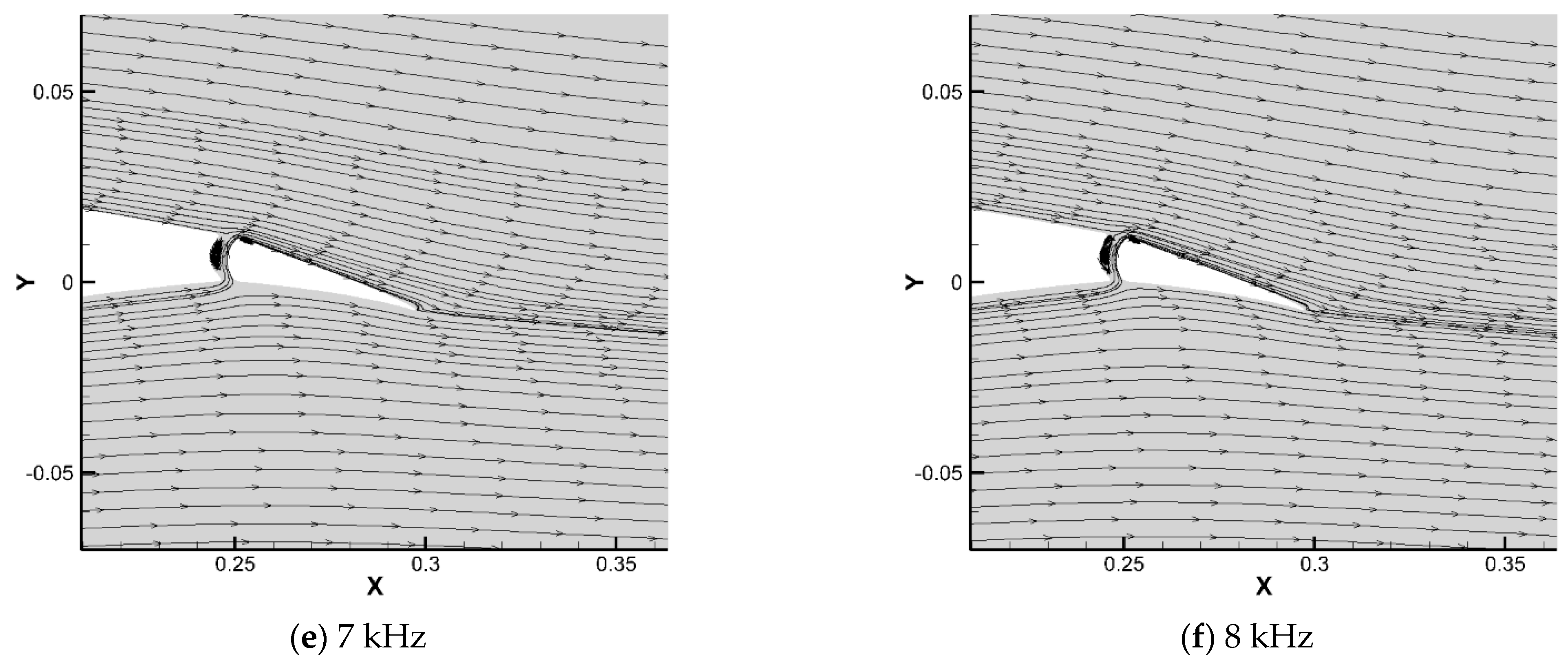

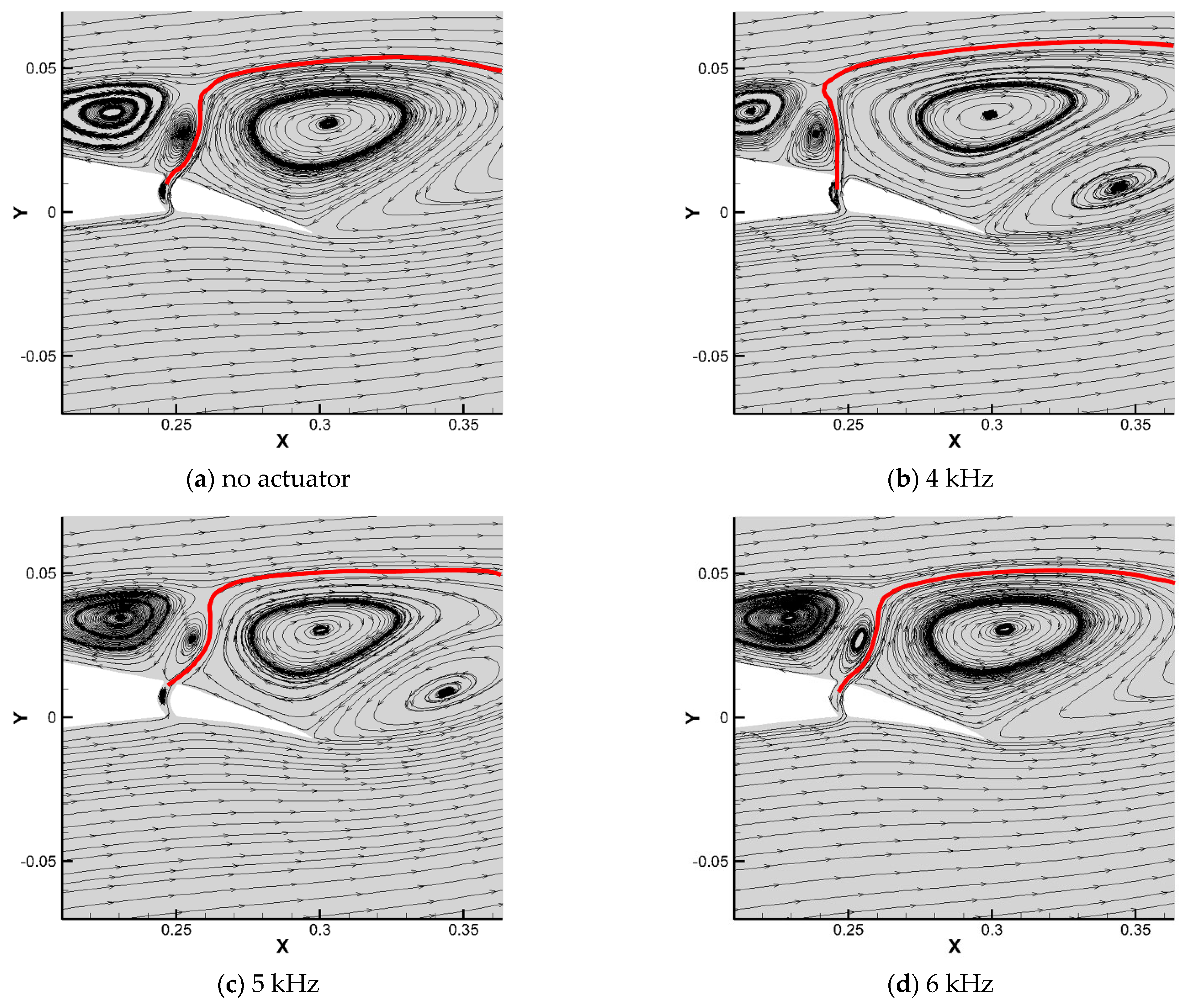
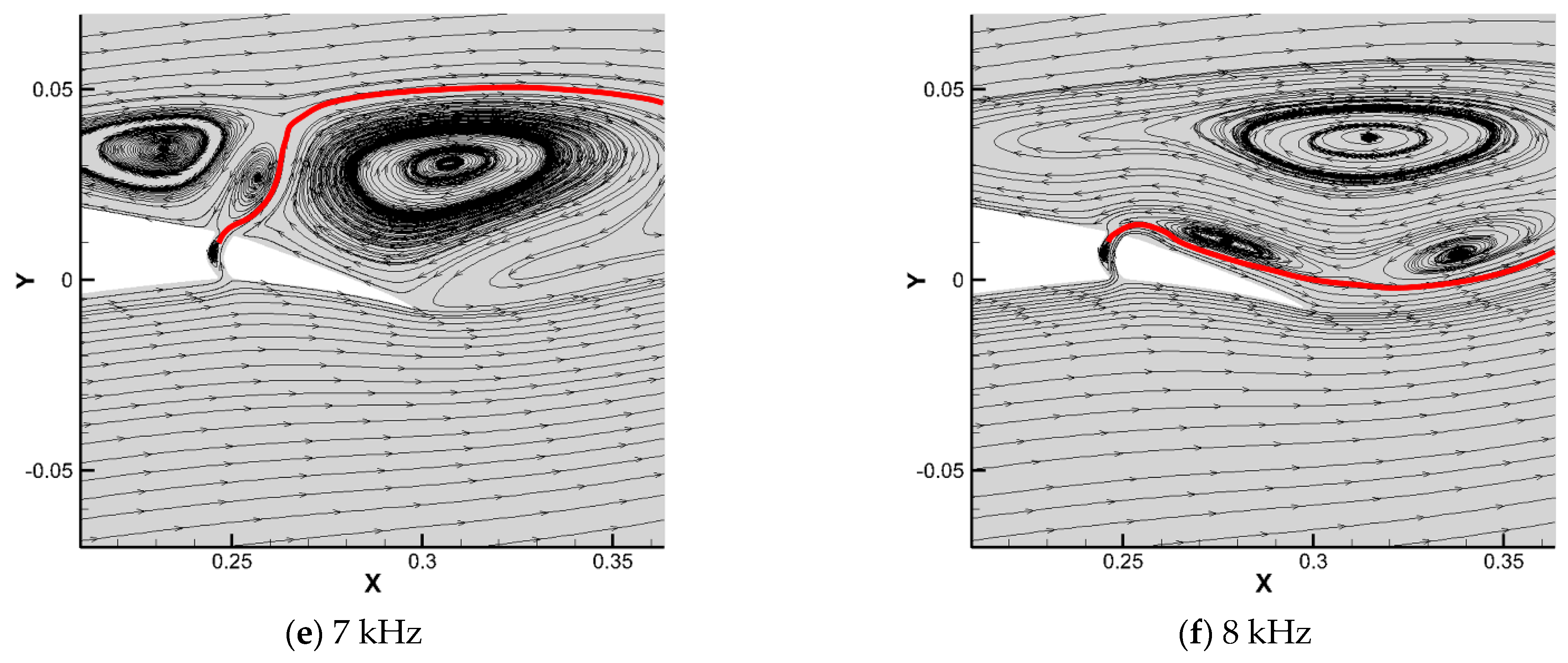
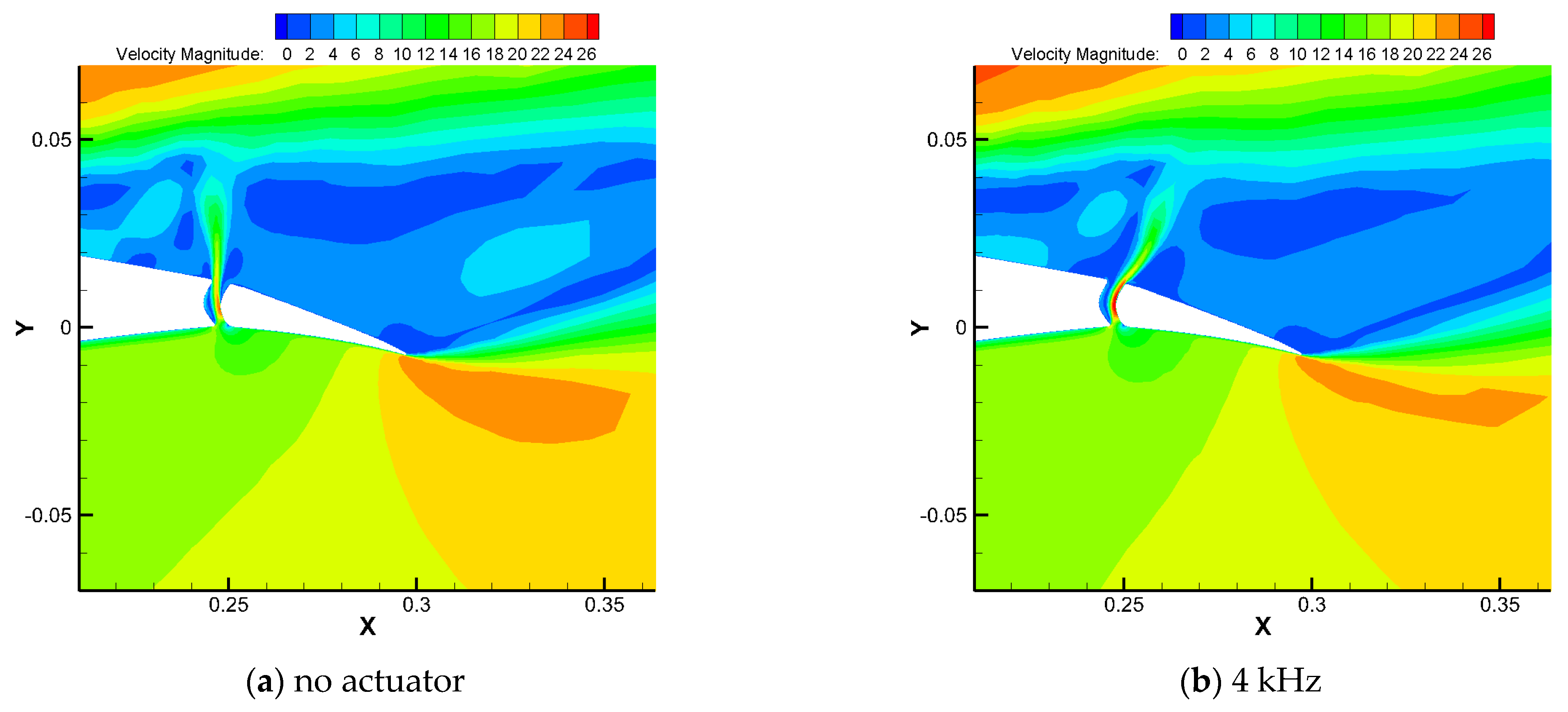
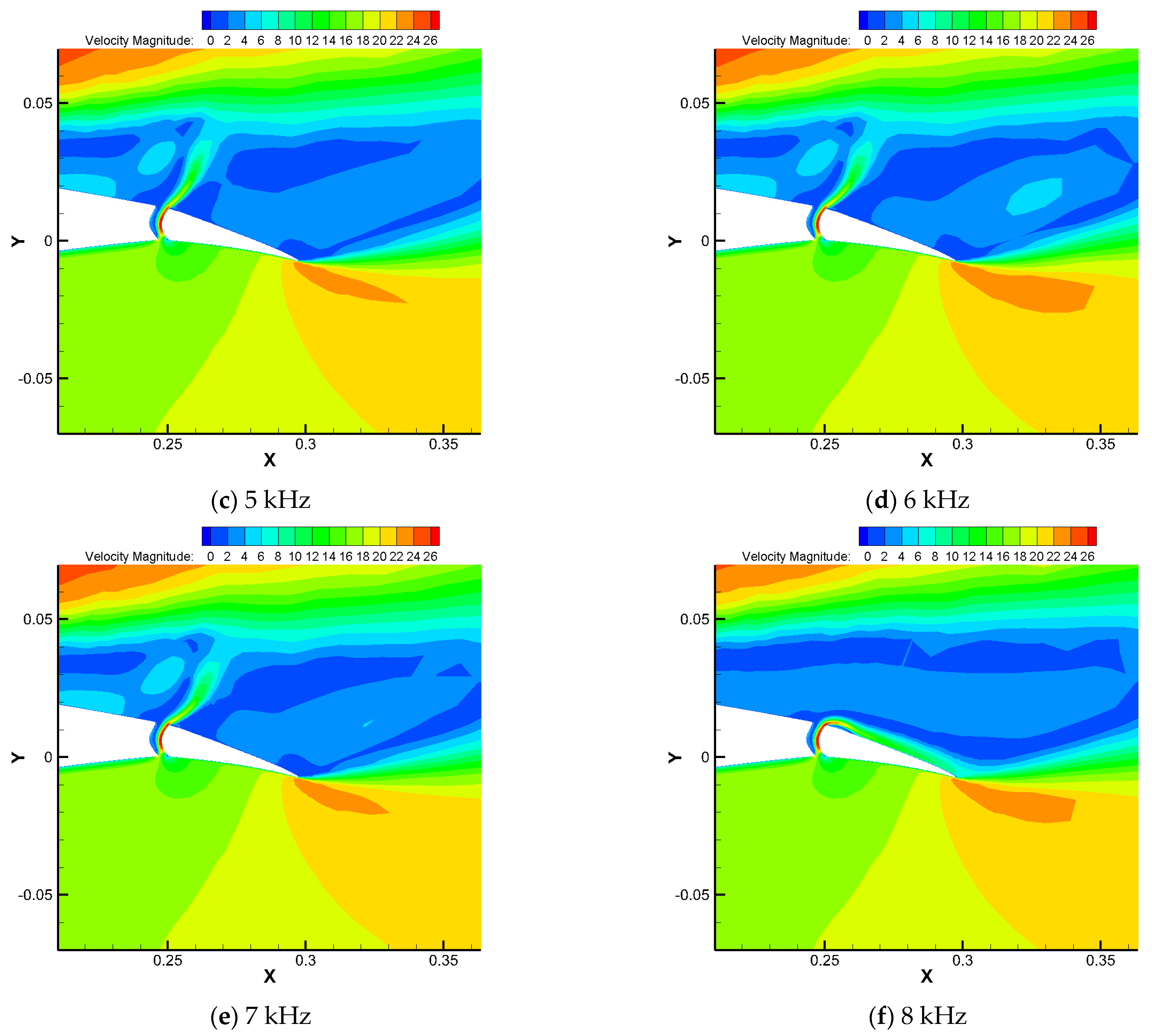
| Voltage Frequency | Voltage Amplitude | Angle of Attack (α) | Angle of Rudder Reflection (β) |
|---|---|---|---|
| 4 kHz, 5 kHz, 6 kHz, 7 kHz, 8 kHz | 5 kV | 0°, 15° | 3°, 4°, 5°, 6°, 7°, 8°, 9° |
| Voltage Frequency | β = 3° | β = 4° | β = 5° | β = 6° | β = 7° | β = 8° | β = 9° |
|---|---|---|---|---|---|---|---|
| No actuator | 0.3603 | 0.3826 | 0.3959 | 0.4277 | 0.4425 | 0.4621 | 0.4755 |
| 4 kHz | 0.4337 | 0.4606 | 0.4489 | 0.4767 | 0.4887 | 0.5045 | 0.5145 |
| 5 kHz | 0.4654 | 0.4962 | 0.4654 | 0.4893 | 0.5009 | 0.5159 | 0.5240 |
| 6 kHz | 0.5501 | 0.6104 | 0.4837 | 0.5029 | 0.5128 | 0.5270 | 0.5335 |
| 7 kHz | 0.5888 | 0.6395 | 0.5058 | 0.5181 | 0.5237 | 0.5378 | 0.5428 |
| 8 kHz | 0.6119 | 0.6583 | 0.5369 | 0.5360 | 0.5358 | 0.5494 | 0.5526 |
| Voltage Frequency | β = 3° | β = 4° | β = 5° | β = 6° | β = 7° | β = 8° | β = 9° |
|---|---|---|---|---|---|---|---|
| No actuator | 1.2589 | 1.2635 | 1.2817 | 1.2821 | 1.3021 | 1.3235 | 1.3340 |
| 4 kHz | 1.2708 | 1.3293 | 1.2903 | 1.2879 | 1.3072 | 1.4179 | 1.4036 |
| 5 kHz | 1.3297 | 1.3400 | 1.2926 | 1.3600 | 1.3844 | 1.4257 | 1.4117 |
| 6 kHz | 1.3375 | 1.3484 | 1.3610 | 1.3687 | 1.3915 | 1.4328 | 1.4181 |
| 7 kHz | 1.3456 | 1.3559 | 1.3682 | 1.3748 | 1.3979 | 1.4379 | 1.4231 |
| 8 kHz | 1.3538 | 1.3417 | 1.3747 | 1.3798 | 1.4031 | 1.4443 | 1.4282 |
| Voltage Frequency | 3°~4° | 4°~5° | 5°~6° | 6°~7° | 7°~8° | 8°~9° |
|---|---|---|---|---|---|---|
| 4 kHz | 21.649% | 13.853% | 12.377% | 10.802% | 9.582% | 8.440% |
| 5 kHz | 31.529% | 18.165% | 15.559% | 13.654% | 12.158% | 10.496% |
| 6 kHz | 63.225% | 22.948% | 18.995% | 16.437% | 14.667% | 12.551% |
| 7 kHz | 71.302% | 28.725% | 22.834% | 18.985% | 17.107% | 14.564% |
| 8 kHz | 76.520% | 36.853% | 27.355% | 21.814% | 19.729% | 16.685% |
| Voltage Frequency | 3°~4° | 4°~5° | 5°~6° | 6°~7° | 7°~8° | 8°~9° |
|---|---|---|---|---|---|---|
| 4 kHz | 1430% | 47% | 1450% | 25% | 441% | 663% |
| 5 kHz | 1663% | 60% | 19475% | 412% | 478% | 740% |
| 6 kHz | 1846% | 436% | 21650% | 446% | 509% | 801% |
| 7 kHz | 2009% | 475% | 23175% | 479% | 535% | 849% |
| 8 kHz | 1700% | 511% | 24425% | 505% | 564% | 897% |
Disclaimer/Publisher’s Note: The statements, opinions and data contained in all publications are solely those of the individual author(s) and contributor(s) and not of MDPI and/or the editor(s). MDPI and/or the editor(s) disclaim responsibility for any injury to people or property resulting from any ideas, methods, instructions or products referred to in the content. |
© 2025 by the authors. Licensee MDPI, Basel, Switzerland. This article is an open access article distributed under the terms and conditions of the Creative Commons Attribution (CC BY) license (https://creativecommons.org/licenses/by/4.0/).
Share and Cite
Xu, J.; Zhao, J.; Chang, J. Effect of Different Voltage Frequencies of Plasma Actuators on Wind Turbine Blade Lift and Rudder Efficiency. Processes 2025, 13, 1032. https://doi.org/10.3390/pr13041032
Xu J, Zhao J, Chang J. Effect of Different Voltage Frequencies of Plasma Actuators on Wind Turbine Blade Lift and Rudder Efficiency. Processes. 2025; 13(4):1032. https://doi.org/10.3390/pr13041032
Chicago/Turabian StyleXu, Junjie, Jian Zhao, and Jianlong Chang. 2025. "Effect of Different Voltage Frequencies of Plasma Actuators on Wind Turbine Blade Lift and Rudder Efficiency" Processes 13, no. 4: 1032. https://doi.org/10.3390/pr13041032
APA StyleXu, J., Zhao, J., & Chang, J. (2025). Effect of Different Voltage Frequencies of Plasma Actuators on Wind Turbine Blade Lift and Rudder Efficiency. Processes, 13(4), 1032. https://doi.org/10.3390/pr13041032







